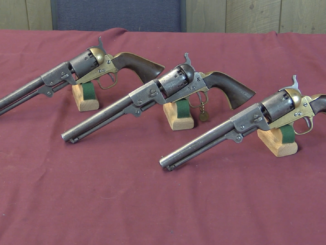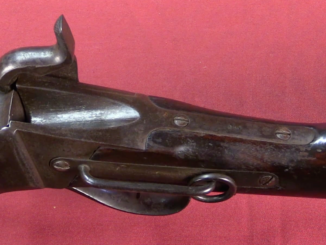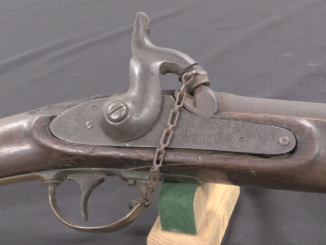George Morse of Baton Rouge patented a design for a remarkably modern centerfire cartridge and breechloading rifle action in 1856 and 1858, using a standard percussion cap as a primer. This was coupled with a gutta percha washer for sealing and a rolled brass cartridge body that was strong and robust – easily reloaded, if somewhat complex to manufacture.
After positive trials by the Army and Navy, Morse received a contract to make first complete guns and then a royalty contract for the conversion of existing muskets to his system. Work began at the Harper’s Ferry Arsenal, but money ran out with only 60 conversion completed. When the Civil War broke out, Morse chose to side with the Confederacy, and the tooling for his conversions was taken from the captured Armory to be put to use. He initially set up in Nashville, but the city fell to the Union in 1862, and he was forced to relocate to Atlanta and the Greenville South Carolina. It was in Greenville that Morse was finally able to manufacture guns in quantity, and he built approximately a thousand brass-framed single shot cartridge carbines for the South Carolina state militia.
Unfortunately for the Confederacy, the infrastructure to supply a modern type of cartridge ammunition really did not exist in the South, and this crippled any chance of Morse’s carbines becoming a significant factor in the war. The best technology in the world is still of no use if ammunition cannot be provided!
This Morse carbine is of the third type, using a sliding latch on the breechblock to hold the action closed when firing. Two previous versions used different and less secure systems, but this third type was introduced around serial number 350 and would comprise the remaining 2/3rds of the production run.




“patented a design for a remarkably modern centerfire cartridge and breechloading rifle action”
Patent US20503A
Improvement in breech-loading fire-arms
is available here: https://www.google.com/patents/US20503
Patent US20727A
Improvement in cartridges
is available here: https://www.google.com/patents/US20727
Morse also much later (in 1887) patented POCKET CARTRIDGE-LOADER
https://www.google.com/patents/US361966
Concerning Morse’s patents, according to https://centerofthewest.org/2016/10/28/breechloader-civil-war-lawsuit-morse-carbine-story/
Following the Civil War, Morse unsuccessfully sued the United States for royalties on the breech loaders they had built or purchased. His lawsuit demanded five dollars for each of over 170,000 arms that he thought infringed on his pre-war patents. Despite his court loss, Morse continued working on cartridge designs for the U.S. Ordnance Department which resulted in two more cartridge patents in the 1880s.
What are that 2 patents from 1880s? One is, as I understand Patent US361966A which I already linked, but where is 2nd?
Does anybody won court case in 1860s against United States concerning weapon technology? If yes who?
Here are a few more George W. Morse patents to add to US20503, US20727, and US361966 above:
US15995
US15996
US20214
US345165
US346213
Hope that helps.
These later Morse cartridges must have been issued to US troops as the gov. published instructions on how to reload them as seen a little ways down this page:
http://www.trapdoorcollector.com/reloadingkits.html
“using a standard percussion cap as a primer”
Wait, this sounds familiar…
to pin-fire (or Lefaucheux) system, according to this:
http://www.hlebooks.com/pinfire/pin01.htm
Percussion caps no 11 are used, however it is modern method, I am not sure if originally plain caps for percussion weapons or special pattern were used?
Considering patent chronology pin-fire (French patent from 1835) is earlier than Morse. Now I am wondering if Morse, when creating his solution, was aware of Lefaucheux development or not?
Ammo for it, looks like standard caps:
http://municion.org/58/58Morse.htm
Raphael revolvers also used centerfire ammo primed with ordinary caps, but those were internal:
http://municion.org/raphael/8×12.htm
http://municion.org/raphael/12×13.htm
So did Javelle revolver:
http://municion.org/javelle/11.htm
And Devisme:
http://municion.org/lefaucheux/11DevismeHorizontalPinfire1849.htm
Treuille de Beaulieu carbines also used very strange round primed internally by a standard percussion cap:
http://municion.org/lefaucheux/9x41TreuilleDeBeaulieu.htm
Back on topic of Morse amnmo, I have seen two examples of the similar ammo/adapters made in Montenegro, a bit cruder than those, but with same basic idea. Those were probably made to enable use of cartridge revolvers with loose powder and caps. They were of .44-45 caliber, so would fit a wide variety of the revolvers in use locally.
“best technology in the world is still of no use if ammunition cannot be provided”
This reminded me about one early derringer:
http://www.antiquearmsinc.com/williamson-deringer-derringer-41-rimfire-percussion-moore-patent-national-firearms-company-pocket-pistol.htm
as it can act as rim-fire weapon or percussion weapon.
I don’t know if a person would actually want to fire one of these old and rare firearms, but it doesn’t look as if it would be that hard to have a batch of shell cases custom made. It wouldn’t be cheap, but not ridiculous considering what the final price will likely be on the gun itself.
Morse was one of the few who probably had the infantryman’s interest in mind. Which soldier wants to play by Napoleonic rules, anyhow? Not me! I’d make like Prussia and develop a breech loading rifle and a new combat doctrine to match!
In fact in United States military breech-loading rifle was produced in 1810s – M1819 Hall: https://en.wikipedia.org/wiki/M1819_Hall_rifle
The Hall rifle was a concept far ahead of the tech level. It had shorter range and penetration performance than muzzle loaders of the day since it leaked lots of propellant gas. Perhaps if a chamber sealing function was added and if the emergency venting was reduced to a few ports, the Hall would have caught on…
“I’d make like Prussia and develop a breech loading rifle and a new combat doctrine to match”
When?
In 1841 – https://en.wikipedia.org/wiki/Dreyse_needle_gun
Hi Ian I really like your reports,I have a large collection of firearms from The War Between The States to Vietnam era.We Southern people do not use the civil war term those of us born and raised in the South we use the War Of Northern Aggression,War For Southern Independence or my first term earlier.Keep up the great job you are doing.Proud Son Of The South this is what I am–Brad–
It looks like the designer designed the gun to keep out mud and dirt–with the hammer forward there are no openings into the mechanism of any significance.
Interesting how there was no bayonet lug and, as Ian pointed out, the stock was very thin. Meant to be shot only, not to be used with a bayonet or to be used as a club.
If noticed, breechblock works in “Toggle Lock” manner. The middle lever joint is below the line of front and rear axis. Therefore, the sliding latch on top, works as a cover closer in all the time and not the action lock at instant of firing.
I have a Morse carbine – serial #552 – which has been in the family for many years. With the exception of part of the hammer having broken off, the piece is in great shape. I’m looking to see this weapon, but have no idea what it is worth, or where to have an honest appraisal of its’ value. Perhaps someone on this site could give me a hint. We are residents of FL from October through April and Ohio from May through September.
Obviously I’m looking to “sell” the Morse carbine, not “see” it.